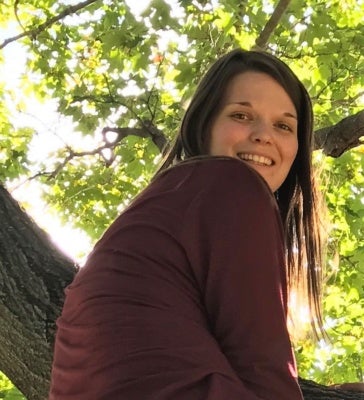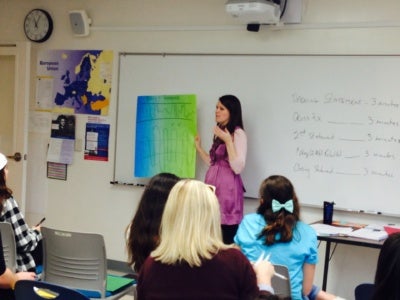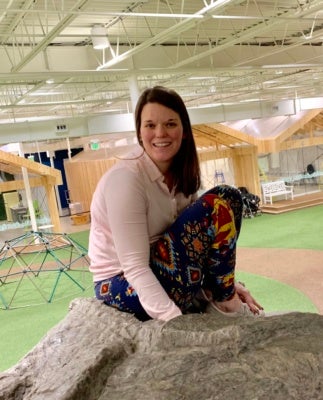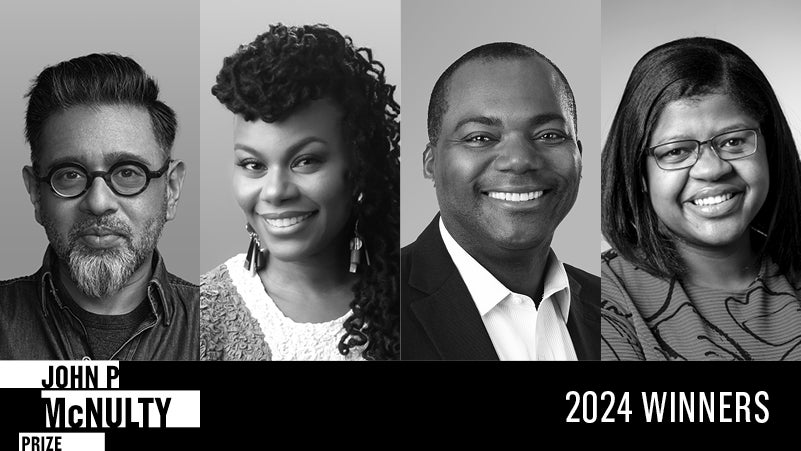If you work with people these days you confront trauma and the effects of trauma. The pain of trauma, whether from abuse, sexual violence, racial injustice or some other cause has a way of spreading outward–from an initial victim or group of victims to friends and family, neighborhoods, and communities.
Amanda Lindamood is deeply dissatisfied with the way our society tries to help people face and heal from trauma. A trauma survivor herself, at 22 Lindamood found herself a department head at a major sexual violence prevention and response organization. Six years later, she’s trying to revolutionize the way we think about the subject.
Trauma isolates the survivor, Lindamood observes. People do not understand what you’ve gone through, or they can’t handle it, or they can’t hold it for long. Trauma victims perceive the violence all around them, which is invisible to the institutional and cultural structures of power that allow it to continue.
Healing must happen at each level of relationship: within the self, with the people immediately around you, and with the rest of society. Amanda has used lots of different healing tools: therapy, writing, running, retreats, centering prayer, meditation, body work, mentorship, creative performance, and more. She is still challenged by her trauma, but she has experienced areas of healing. One of her most powerful healing tools is writing. In the past year, she has expanded a journaling project into a full book that explores healing themes, especially accountability.
Amanda uses her writing to engage one of the most significant effects of trauma, fragmentation. Trauma often causes different parts of the psyche to disassociate from one another and develop independent reactions and strategies in response to the traumatic event. In a characteristically creative move, Amanda has turned this into a strength: she has written her book in the form of a conversation among the different parts of herself.
Amanda shared parts of her draft with me, and the first thing one notices, after her eloquence, is the  stark honesty of the writing. “We need to not collapse the truth,” she says. “We need to not fail to say how much more complicated trauma is than the story we typically tell society. One of the reasons people turn away from our work is that they intuitively know that the simplicity of the tools offered doesn’t match the complexity of their experiences.”
stark honesty of the writing. “We need to not collapse the truth,” she says. “We need to not fail to say how much more complicated trauma is than the story we typically tell society. One of the reasons people turn away from our work is that they intuitively know that the simplicity of the tools offered doesn’t match the complexity of their experiences.”
We need to acknowledge, for example, “how trauma doesn’t disappear from our lives. It’s a change…you’re not going to be able to power through it like a marathon. This is not a victory narrative. If you say it is, then you set people up to be devastated when they realize what they thought was the end wasn’t the end. How do we not undersell what healing is and what it’s going to take from you?”
Her rigorous honesty is a key element of her efficacy in building relationships that can hold trauma.
“Words like victory or celebration or past are never said by my survivor part. Words like empowerment are never said by my advocacy part. I am looking for words that feel real. We must resist blending distinct living things into one – it reduces our parts to a whole and fails to address how you’ve been fractured.”
Amanda also had to heal the relationships between the different parts of her. “I understand myself as having multiple perspectives within myself. Multiple encounters with trauma have produced different points of view and different emotions. It was important for me to find a way to give voice to those separately, and then to look at power dynamics even within my own internal experience, which I could then transfer to relationships with other people.”
“Even within my writing, there are moments when I am speaking as a survivor to myself as an advocate. ‘These are the reasons I don’t accept your advocacy on our behalf. You can’t stay neutral, you do overpower my instincts, you’re not honest about that. What does it mean to say I’m agreeing to do something and you’re not honoring the toll that that takes?’”
 It’s essential, to her, that healing be comprehensive. Honesty means acknowledging the links between individual violence and state violence. Amanda cares deeply about illuminating the way people maintain perceptions of their own innocence, and the way this intersects with racial and economic injustice.
It’s essential, to her, that healing be comprehensive. Honesty means acknowledging the links between individual violence and state violence. Amanda cares deeply about illuminating the way people maintain perceptions of their own innocence, and the way this intersects with racial and economic injustice.
Healing must also be intergenerational. She envisions a world in which kids grow up with skills, language and resources she did not have, and in which adults receive sufficient support that they can handle their own trauma better. If adults receive this support, they will be better parents, and we can disrupt the intergenerational cycle of trauma.
Consent
Essentially, what is needed is an ethic, a new moral code for relationships that is meant to prevent violence. This code has to be practical and down to earth, integrated into daily life, habits, and muscle memory.
In exploring the relationships among different parts of herself, Amanda has developed just such a code. Its core concept is consent.
It’s worth taking a moment here to explain consent. In mainstream culture we typically apply the concept only to the context of sex, but Amanda believes it should apply in nearly every human interaction. And if you listen to her long enough, you can see why.
Traumatic violence is a profound violation of dignity, and at its core is indifference to another soul, willingness to act in absolute disregard for the value of that human being. It is a violation of will and the opportunity to control what happens to one’s body. By contrast, one of the clearest ways to honor human dignity is deference to the ability of each person to choose what happens to them.
Even when explicit violence is not present, in relationships characterized by a power dynamic, it’s easy for slights small or large to insult the dignity of one party. The ethic Amanda proposes to safeguard against these slights, whether subtle or extreme, is one that seeks the affirmative agreement – the consent – of all parties in each interaction.
The consent ethic is often portrayed as a cumbersome, legalistic form of interaction, and in some manifestations it would be. But in Amanda’s expression of it, it’s simply a frame shift: “In my capacity as a trainer, I don’t believe in safe spaces. I’m more interested in how we make community agreements.”
Amanda next step professionally is to go back to school to develop and study these ideas. She emphasizes that she has had tremendous mentors, and has been lucky to have opportunities to take creative risks supported by leadership, in this area and others. She now wants to understand how to use community agreement, this form of honoring human dignity, in all sorts of situations. “What does consent mean in the workplace, with your boss? In home buying? Care of children? Who do we think needs to be involved in what decisions?”
As is appropriate to any thorough ethic, Amanda has a daily practice that helps her live out her commitment to this frame. “My sense of both healing and accountability has been about refining a definition of consent that I can reflect back on each day – how did I do at valuing my own consent and that of others?”
Amanda’s aim is nothing less than to radically improve the way relationships work when they come into contact with the volatile element of power. As she puts it, “I am interested in creating an implicit motivation for us to be accountable to each other.” The goal is to help us be more credibly responsible to one another.
Centering the Harm
Interestingly, the same lessons Amanda has learned in her inner work apply to the biggest conflicts we see in society today. These, too, are deeply affected by trauma.
Much is written and said about the level of division in society today, lamenting it and measuring it and analyzing it. But one element that is almost entirely unspoken is the degree to which trauma-based dynamics are destroying relationships between and within groups. In order for society to function we desperately need to be able to navigate harm, accountability, and ultimately resolution and even forgiveness, and yet those processes are not only ineffective but forgotten in most social commentary.
Media descriptions make these conflicts sound deceptively abstract, but in truth they are also personal and extremely human. That means we can address them with similar healing tools to those necessary to heal a single heart.
Amanda describes trauma as an “unnamed factor” in our understanding of – well, most things in society, including our dysfunctional public discourse.
The first thing to know is that trauma is universal. This is not to say that everyone has experienced the equivalent of being a survivor of sexual violence or a school shooting or a war. Certainly not. Yet in a simple sense, “the trauma response is about looking at what are the moments where we can’t tolerate our experiences. That intolerance changes the way our brains and bodies are programmed to respond. That is a universal human response, and because it’s universal, there are very few situations where it’s not relevant. And because it changes your perception, it changes your relationship with your body, your sense of connection and safety. All the other questions we’re asking include those themes.
As an example, she points to the national conversation about race. She notes that the body processes experiences of shame as trauma – something which cannot be tolerated – and that according to studies, in the U.S. being called a “racist” generates more shame than any term except “pedophile.” Trauma responses make it impossible to engage productively: “When I’m in fight flight freeze, you can’t change my beliefs, you can’t give me information that is going to change my mind about something. The only takeaway while I’m triggered will be that that becomes an example of something that triggers me. How do you get a country of white people to be able to hold their emotional response to being told they have privilege if they’re encoding it as a trauma response?”
In an era where we are, as she puts it, “effectively ousting offenders,” Amanda is thinking about what it means to create conversations that can allow all the members of a community to come to the table and engage.
She goes on to describe the right way to respond to harm, and it is to “center” the harm, to keep the harm as the focus of the conversation. In order to do that, “if I have caused the harm, I have to be in a place where I can tolerate that knowledge and react to it.”
What is needed to give us the capacity to tolerate this kind of idea? Amanda has an answer for that too: “We have to be capable of identifying ourselves as capable of causing harm, witnessing harm, and experiencing harm. We first have to build up our emotional tolerance to be called out for causing harm….I have to be able to say I am capable of violating boundaries, acting in a way that’s not consensual, and of having a negative impact of someone.
“If I can’t do that, I can’t have a conversation about accountability because it turns into a conversation about whether accusation is justified. It decenters the harm.”
Creating a world in which we are capable of tolerating accusations that generate shame well enough to think clearly and respond compassionately is a tall order. But the first step is understanding what is required. Most public discourse these days is a matter of asserting one ideology or another; very few thinkers move beyond their framework to make room for the people it excludes. This one does.
Until We Feel a Whole Emerge
It is sometimes those who have undergone great suffering who have the most insight to offer. Amanda has lived out a powerful lesson: that what it takes to make peace within yourself has a great deal to do with what you have to offer the world. And the world needs her, and many others like her. We are still only beginning to understand the staggering effects of trauma in nearly every aspect of life, much less to develop tools sufficient to deal with them.
The good news is that now that we are beginning to understand trauma, and the appetite exists to deal with it in a new way, we can grow to more effectively heal not only our own hearts but also our communities and our society en masse. Each situation is different, but healing always begins with transformation of relationships. Rigorous truth-telling is required, and an ethic that actively seeks to respect the dignity of each soul. You have to learn to handle your own inner experiences in the midst of conflict, and to be able to understand yourself as capable of causing harm or experiencing it, while focusing intently on the harm for which healing is needed.
 Amanda is among a vanguard of leaders who are committed to a world in which a whole person is welcome in all spaces, including the workplace, and where relationships comprehend and hold trauma rather than punishing survivors. She’s doing her part, and she’s not alone. We are all too aware these days of the wickedness of this problem, but there is a dawn breaking too, in the form of a mass movement to look deeply at trauma, staying in the dark trenches of a soul long enough to see a path emerge to healing and to hope.
Amanda is among a vanguard of leaders who are committed to a world in which a whole person is welcome in all spaces, including the workplace, and where relationships comprehend and hold trauma rather than punishing survivors. She’s doing her part, and she’s not alone. We are all too aware these days of the wickedness of this problem, but there is a dawn breaking too, in the form of a mass movement to look deeply at trauma, staying in the dark trenches of a soul long enough to see a path emerge to healing and to hope.
Amanda’s book includes a letter to her community. She writes, “Let us have courage to speak in parts until we feel a whole emerge. Loss is here, and it is long-lasting, but today I am smiling as I sense what is nearby.”

